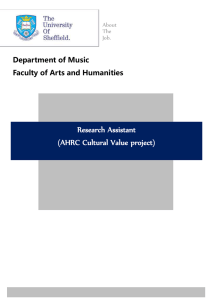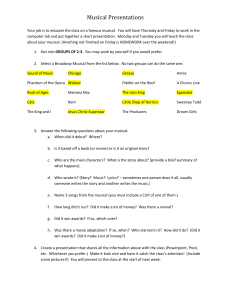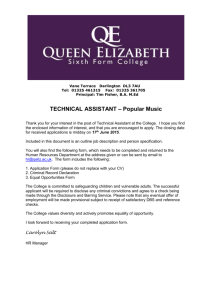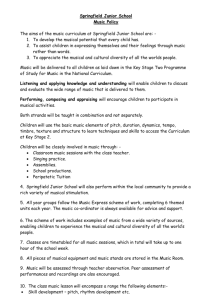Headline findings from Cultural Value project
advertisement
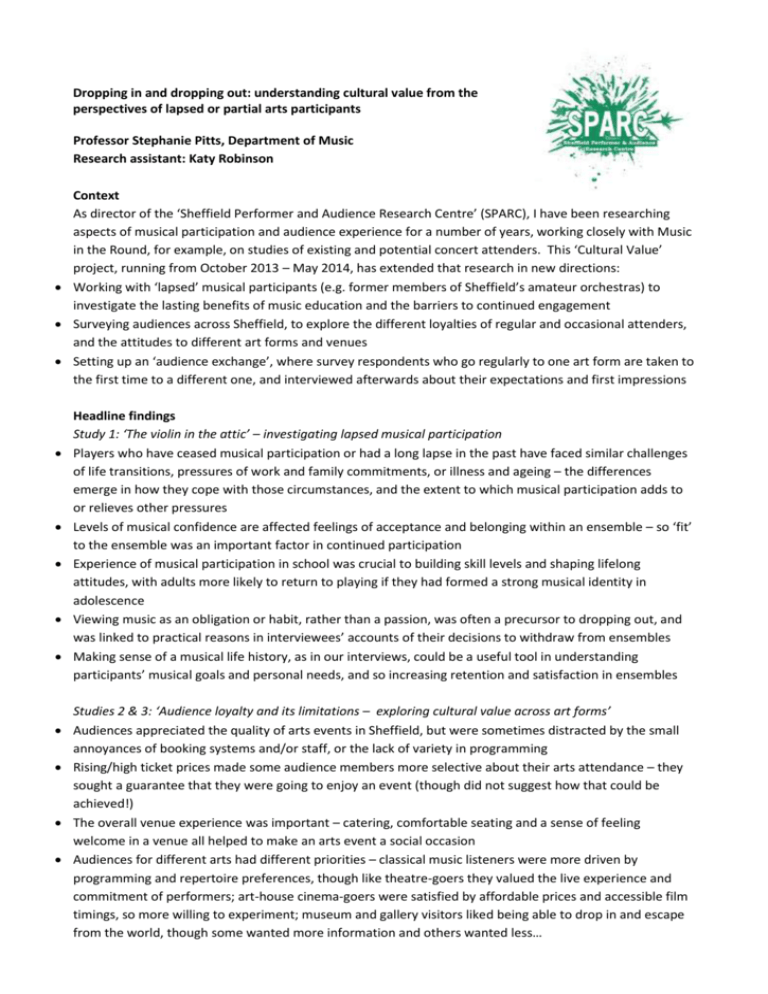
Dropping in and dropping out: understanding cultural value from the perspectives of lapsed or partial arts participants Professor Stephanie Pitts, Department of Music Research assistant: Katy Robinson Context As director of the ‘Sheffield Performer and Audience Research Centre’ (SPARC), I have been researching aspects of musical participation and audience experience for a number of years, working closely with Music in the Round, for example, on studies of existing and potential concert attenders. This ‘Cultural Value’ project, running from October 2013 – May 2014, has extended that research in new directions: Working with ‘lapsed’ musical participants (e.g. former members of Sheffield’s amateur orchestras) to investigate the lasting benefits of music education and the barriers to continued engagement Surveying audiences across Sheffield, to explore the different loyalties of regular and occasional attenders, and the attitudes to different art forms and venues Setting up an ‘audience exchange’, where survey respondents who go regularly to one art form are taken to the first time to a different one, and interviewed afterwards about their expectations and first impressions Headline findings Study 1: ‘The violin in the attic’ – investigating lapsed musical participation Players who have ceased musical participation or had a long lapse in the past have faced similar challenges of life transitions, pressures of work and family commitments, or illness and ageing – the differences emerge in how they cope with those circumstances, and the extent to which musical participation adds to or relieves other pressures Levels of musical confidence are affected feelings of acceptance and belonging within an ensemble – so ‘fit’ to the ensemble was an important factor in continued participation Experience of musical participation in school was crucial to building skill levels and shaping lifelong attitudes, with adults more likely to return to playing if they had formed a strong musical identity in adolescence Viewing music as an obligation or habit, rather than a passion, was often a precursor to dropping out, and was linked to practical reasons in interviewees’ accounts of their decisions to withdraw from ensembles Making sense of a musical life history, as in our interviews, could be a useful tool in understanding participants’ musical goals and personal needs, and so increasing retention and satisfaction in ensembles Studies 2 & 3: ‘Audience loyalty and its limitations – exploring cultural value across art forms’ Audiences appreciated the quality of arts events in Sheffield, but were sometimes distracted by the small annoyances of booking systems and/or staff, or the lack of variety in programming Rising/high ticket prices made some audience members more selective about their arts attendance – they sought a guarantee that they were going to enjoy an event (though did not suggest how that could be achieved!) The overall venue experience was important – catering, comfortable seating and a sense of feeling welcome in a venue all helped to make an arts event a social occasion Audiences for different arts had different priorities – classical music listeners were more driven by programming and repertoire preferences, though like theatre-goers they valued the live experience and commitment of performers; art-house cinema-goers were satisfied by affordable prices and accessible film timings, so more willing to experiment; museum and gallery visitors liked being able to drop in and escape from the world, though some wanted more information and others wanted less… New audiences (our ‘audience exchange’ focus groups) had quite different experiences from regular attenders and often expected an event to be more ‘posh’ or inaccessible than it is – they wanted more background knowledge in order to be enjoy an opera, jazz gig or classical concert, and sometimes found it hard to know how to concentrate or appreciate the event Next steps Having completed this research, we are meeting with the Culture Consortium group of Sheffield arts venues to discuss a more practically-focused project with a view to bidding to the AHRC Follow on Funding scheme. Collaborative strategies might include one or more of the following: Audience exchange: Continuation of the audience exchange scheme, over a wider range of arts events and a longer period of time, to judge the impact of a first arts experience on subsequent involvement and interest. A “Bring a friend” scheme: Asking members of Friends’ schemes or mailing lists of organisations to ‘bring a friend’ new to the art form, and to discuss their experiences together afterwards, building up a collection of stories about first-time and established audience members. “Artsadvisor” website: Addressing the challenge of needing a guaranteed good night out, a website could be set up to source ratings and reviews from audience members, which would be useful in building audience community and increasing awareness of current events.

